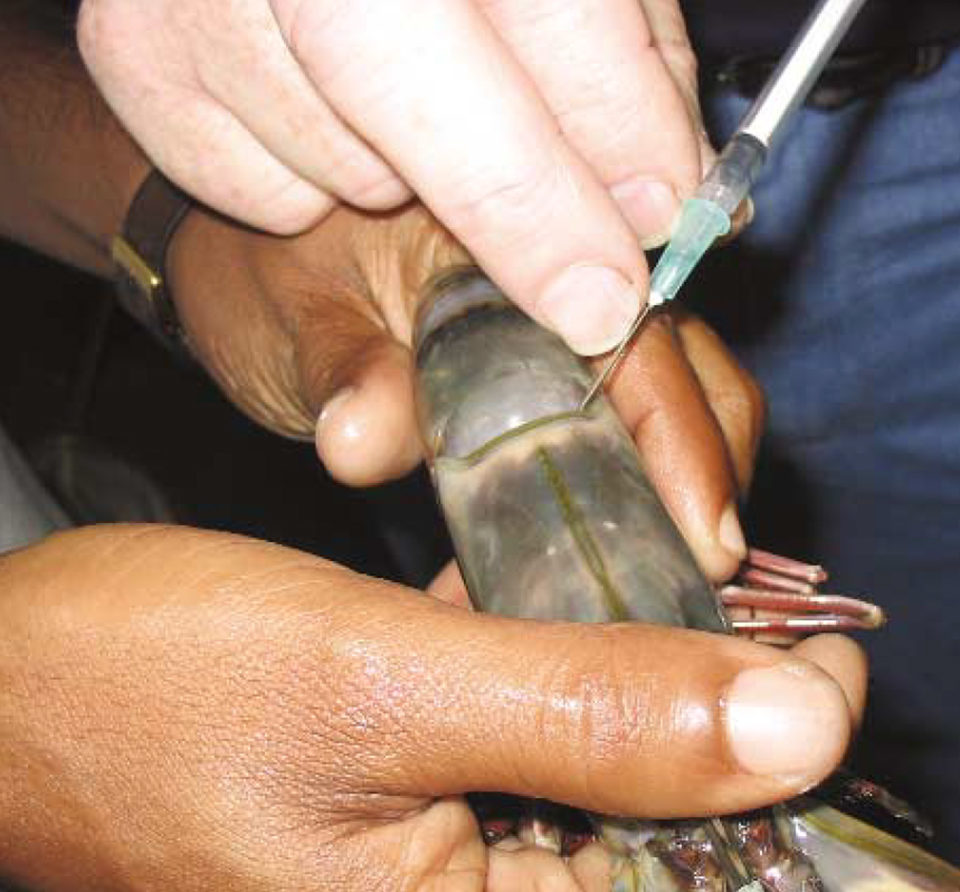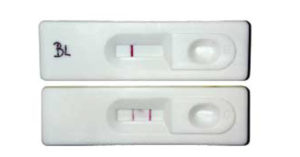Quick results for viral disease detection without a laboratory

Until recently, the screening and diagnosis of shrimp viral pathogens required the backup of a suitably equipped laboratory and well-trained staff. Due to the laborious procedures used and the often long distance between the labs and farming areas, results from the analysis could take up to a week to be delivered.
Many disease outbreaks were therefore not properly diagnosed in a timely manner. In effect, results were often a “postmortem” diagnosis that did not allow any intervention.
More diagnostic tools available
Nowadays an increasing number of diagnostic and screening tools specifically developed for field use are available in the commercial market. These kits can be used without the backup of a laboratory, and results are available in a few minutes to a few hours. The two types of kits are based on different detection methods: antibodies and polymerase chain reaction (PCR).
Antibody-based kits
Antibody-based kits are low-sensitivity systems appropriate for the diagnosis of clinical diseases. They have been developed to detect the main viral pathogens in unhealthy and moribund animals. Table 1 profiles several types of antibody-based kits.
Alday-Sanz, Screening tools for diagnosing shrimp diseases, Table 1
| Products | Immunosquash | Dot Blot, Immunoblot | Test Strips | Field Polymerase Chain Reaction |
|---|
Products | Immunosquash | Dot Blot, Immunoblot | Test Strips | Field Polymerase Chain Reaction |
|---|---|---|---|---|
| Company | DiagXotics | DiagXotics | Biotech, Inve, Shrimple | Farming IntelliGene |
| Equipment required | Microscope | Oven | None | None |
| Duration of procedure | Two hours | Three to five hours | Five minutes | |
| Technique | Immunohistochemistry | DNA extraction, dot blot, immunoblot | Lateral flow, one step, sandwich immunoassay | Isothermal nucleic acid amplification |
| Tissue sample collection | Gill lamella | Gill, pleopod, haemolymph | Gill, pleopod, haemolymph | |
| Comments | Certain degree of training needed | Risk of false positives, long procedure | No training required | High level of training needed |
| Sensitivity | Low | Low | Low | High |
| Intended use | Disease outbreak diagnosis | Disease outbreak diagnosis | Disease outbreak diagnosis | Screening |

Whenever there is an increase of moribund or dead animals in ponds, these kits can provide an accurate diagnosis of the problem. In these cases, higher sensitivity is not adequate, as the mere presence of the pathogen does not mean the onset of disease. The sensitivity of the kits, estimated at approximately 10,000 viral particles in field samples, is lower than that of one-step PCR.
Fig. 1 shows an example of an antibody-based commercial strip test. One band in the window means the test is negative but performing correctly. Two bands in the window means a positive result. The intensity of the second band can vary with the concentration of the pathogen in the sample. No band in the window means the test failed and needs to be repeated again using a new strip.
Field PCR kits
Field PCR testing has recently been developed for shrimp viral pathogens. It allows performing the whole process at room temperature (no need for a thermocycler), and the steps involved were designed so no additional equipment is needed. With sensitivity equivalent to nested PCR, the most sensitive technique currently available, field PCR kits are recommended for the screening of postlarvae prior to stocking.
Management decisions
Diagnostic results are only part of the information that must be considered in making health management decisions. Other factors, including environmental conditions and economic risks, also must be evaluated.
An increasing number of dying animals on the side of a pond that tests positive for White Spot Syndrome Virus or Yellow Head Virus is likely to forecast a serious mortality outbreak within a short period of time. Emergency harvest is a possible strategy to reduce the losses, while the use of antibiotics – which do not effect viral path-ogens – is not recommended.
(Editor’s Note: This article was originally published in the August 2005 print edition of the Global Aquaculture Advocate.)
Now that you've reached the end of the article ...
… please consider supporting GSA’s mission to advance responsible seafood practices through education, advocacy and third-party assurances. The Advocate aims to document the evolution of responsible seafood practices and share the expansive knowledge of our vast network of contributors.
By becoming a Global Seafood Alliance member, you’re ensuring that all of the pre-competitive work we do through member benefits, resources and events can continue. Individual membership costs just $50 a year.
Not a GSA member? Join us.
Author
-
Victoria Alday-Sanz, Ph.D.
INVE Technology NV
Oeverstraat 7
B-9200 Baasrode, Belgium
Tagged With
Related Posts

Health & Welfare
A comprehensive look at the Proficiency Test for farmed shrimp
The University of Arizona Aquaculture Pathology Laboratory has carried out the Proficiency Test (PT) since 2005, with 300-plus diagnostic laboratories participating while improving their capabilities in the diagnosis of several shrimp pathogens.

Innovation & Investment
Aquafeed ingredient AlgaPrime wins GAA Innovation Award
A proliferation of alternative feed ingredients has allowed aquaculture to extend the natural resources it depends on. AlgaPrime, packed with the long-chain omega-3 fatty acid DHA, is being recognized as a game-changing innovation for aquaculture feeds.

Innovation & Investment
GOAL 2017 recap: The aquaculture opportunity has hurdles to clear
The great aquaculture opportunity – assuming responsibility as a reliable and predictable source of nutrition for a growing global population – would be better accomplished with a greater sense of confidence, according to keynote speaker Pearse Lyons.

Innovation & Investment
Investment firm raising funds for paper-based disease test kits
Gaskiya Diagnostics’ paper-based diagnostic test kits could allow fish farmers to test for disease-causing pathogens before they impact the entire stock.


